Abstract
In recent decades, population increase and urban development have led to catastrophic environmental consequences. One of the principal objectives to achieve “sustainable development” is to find suitable landfills. Due to their physical characteristics, which have led to a lack of landfill sites and closeness to water bodies, agricultural fields, and residential areas, the cities of Javanrood, Paveh, and Ravansar were chosen as the necessary research regions. On the other hand, these landfills are unable to accommodate the growing urban population. Therefore, this study attempts to develop a framework for spotting the most suitable sites for landfill construction with these three cities as case studies. For this, 10 important driving factors (9 factors and 1 constraint) in landfill site selection were generated. Second, for the fuzzy membership function, the analytic hierarchy process (AHP) method was employed for the standardization of criteria and determining the weight of the driving factors. Then, the Boolean, weighted linear combination (WLC) and ordered weighted average (OWA) methods were utilized to spot optimal sites for landfills. Finally, two suitable sites were found for landfills: site (a) was obtained from the WLC, and site (b) was obtained from OWA-low risk some trade-off (LRST) methods. Our results proved the high efficiency of multi-criteria decision-making methodology for landfill site selection.
1. Introduction
Nowadays, the city population increase and migration from villages to cities as a consequence of flawed urban planning and environmental planning, as well as alterations in consumption patterns, have led to environmental pollution and a dramatic increase in waste generation [1,2]. One of the most crucial side effects of urbanization and industrialization is health issues which are caused by rapid population growth in cities. Hence, assessing and managing solid waste is a critical act in municipal administration. Furthermore, through solid waste biodegradation in landfills, greenhouse gases (GHGs) are released into the atmosphere, accelerating global warming [3,4]. Due to rapid economic growth, urbanization, population growth, and increasing types of waste, instead of a separate management system for each type of waste, we require an integrated, sustainable approach that encompasses all waste [5,6]. Currently, one of the major issues of the urban environment is selecting the methods to eliminate and dispose of solid waste from the city [7,8,9]. A comprehensive solid waste management strategy should take into account all aspects, from waste generation to disposal procedure, in order to preserve public health and promote environmental sustainability [10,11,12]. Waste management consists of numerous factors, e.g., waste source reduction, waste collection, on-site processing and storage, waste transportation, material and energy recovery, and waste disposal [13,14]. Despite various studies on alternative management methods, landfilling continues to be an inseparable part of solid waste management [15,16]. Municipalities and local governments are urged to manage a healthy and livable environment to overcome these challenges [17,18,19]. The use of singular tools and technologies is imperative to achieving a suitable landfill site. Although landfilling is one of the most broadly used and cost-effective disposal technologies, it requires detailed and wide evaluation, which takes into account the necessities of governmental and environmental regulations [6,20]. The landfill site selection depends on the specific factors which are encountered in a special significance and even have a limitation in the selection of landfills [21,22]. To assess, design, and select a suitable landfill site, extensive research has to be conducted, and all related factors, which include land use, geology, elevation, slope, distance from the residential area, fault, river, protected areas, and the road, should be considered [23,24,25]. In other words, selecting an optimal landfill site requires multi-criteria decision making (MCDM) [22,26,27]. Many landfill site selection studies have been conducted in Iran, such as in Fars province [28], in Naein [29], in Rudbar [30], in Ahvaz [31], in Naqadeh [32], and in Gilan city [33].
Additionally, plenty of investigations into landfill site selection have been conducted all around the world, such as in Iraq [34], in Morocco [35], in Serbia [36], in Turkey [37], and in Pakistan [38]. In these studies, modern tools, such as geographic information systems and remote sensing, are used for optimal landfill site selection in most of the world.
According to the literature review, the most common methods for landfill site selection, approaching multi-criteria decision (MCDM) are weighted linear combination (WLC), ordered weighted average (OWA), analytic hierarchy process (AHP) [39,40,41,42], fuzzy analytic hierarchy process (F-AHP) [6,29,43,44], TODIM, fuzzy TODIM [45], analytic network process (ANP) [26], fuzzy analytical network process (F-ANP) [16], and best–worst method (BWM) [1,10]. They all use GIS to combine spatial data, such as maps, aerial photographs, and satellite imagery with quantitative and qualitative databases, to select an optimal landfill that has the least negative impact on the environment. The main novelty of this research is the combination of AHP, fuzzy logic, Boolean, WLC, OWA and multi-criteria decision making for landfill site selection between three cities with special topographic conditions, such as steep slopes, and the existence of a large number of faults and rivers. Another addition to the novelty is the exploration of a landfill site which is accessible to all three cities in order to reduce the costs and also diminish the negative environmental impacts.
The reasons for choosing these three cities as the study area are that first, due to the topographic condition of Paveh city, there is no landfill site; second, the landfill of Ravansar city is very close to the water bodies and agricultural lands, so wide conflagrations spread rapidly through the land; and third, the landfill of Javanrood city is actually in the residential area. Additionally, the current landfills are insufficient to meet the growing population of this city. On the other hand, the accumulation of these cities’ waste can cause a lot of health and environmental problems, such as leachate, soil pollution, and stench. Therefore, according to the demand for landfill sites in these cities and their proximity to each other, the best landfill was chosen outside of the residential area that has the least negative environmental impact. Furthermore, based on previous studies, the most important parameters for selecting a landfill site are as follows: residential areas [28], land-use type [46], faults, and water bodies’ proximity [41], land slope [1], elevation [47], geology [5], protected areas [6], and roads [16]. The hypothesis of this research is that landfill site selection depends on driving factors, such as elevation, slope, geology, land use, distance from the river, road, residential area, protected area, and faults, and that by using GIS-based methods and the MCDM approach, suitable areas can be spotted. Due to data scarcity, especially in the developing countries, we need to make some simplifications; therefore, we select some more important driving factors. Selecting the optimal landfill site can significantly minimize the environmental impacts of landfills and help in achieving the sustainable development goals.
The goal of this investigation was to utilize GIS for selecting a suitable landfill site for three neighboring municipalities, as the case study, outside of the residential areas by regarding the environmental parameters as an efficient strategy that takes into account all constraints at the same time. As a result, first, the important factors for landfill site selection, including distance from water bodies, roads, faults, residential areas (city and village), protected areas, elevation, land use, geology, and slope, were applied. Second, the AHP method was used for the standardization of criteria and weighting of the factors. Then, by using the Boolean and fuzzy methods, which include WLC, and OWA, suitable locations were investigated for proper waste disposal.
2. Materials
2.1. Study Area
The study area in this paper was three cities, Javanrod, Paveh, and Ravansar, which are located in the North of Kermanshah province in the west of Iran (Table 1, Figure 1). These cities extend between 46°21′ E and 46°48′ E longitudes and 34°31′ N and 34°59′ N latitudes. These three cities are in the mountainous area, as the general height of the study area is varied from a minimum of 1540 m to a maximum of 3350 m above mean sea level with an area of 276,127 ha and a population of 183,257 people [48]. The average annual temperature is 15.7 °C, and the average annual precipitation is 643.6 mm, so they have a cold and moderate humid climate. The total forest area of these three cities is 113,025 ha, the total area of dryland cultivation is 45,476 ha, and the total area under irrigated cultivation is 14,288 ha. The increase in economic and industrial development and population growth caused solid waste generation enhancement in these cities. It is estimated that solid waste production in the study area is 180 tons/day, as Javanrood, Paveh, and Ravansar have about 100-, 40-, and 30-ton production of waste per day, respectively [48].

Table 1.
Statistics of three municipalities of case study.
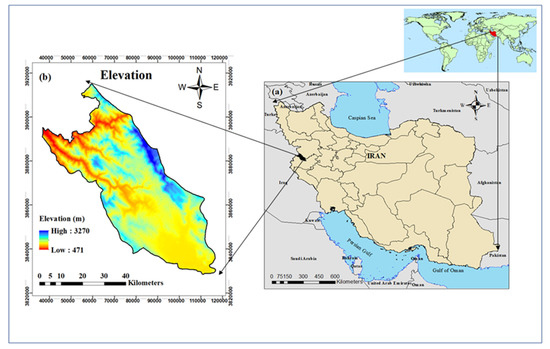
Figure 1.
Location of the study area in Iran (a) and Kermanshah province (b).
2.2. Data Preparation
The first step in finding the best accessible location for the landfill site is to define the appropriate criteria. As it is a multi-criteria decision and has serious environmental, economic, and social impacts, they were chosen based on national regulations, standards and guidelines, local features, previous studies, expert assessments, and data availability [49,50,51,52,53,54]. By gathering the data layers from the National Geoscience Database of Iran, some factors and constraints were determined, as explained below (Table 2). Factors are indicators that increase or decrease the final suitability for a specific goal, and the constraint, which is usually based on the Boolean method (0 and 1), limits the goal. In this study, we do not consider the role of some criteria, such as land ownership, that can affect the final site selection or some criteria because there are no data on them. The reason is that such criteria cannot be entered into the model; however, we take into account these criteria at the stage of the site survey.

Table 2.
The criteria used for landfill site selection.
Description of Factors and Constraints
Below is a detailed explanation of the most significant criteria that were chosen and assessed based on the literature review; also, this section describes how to create thematic maps of factors and constraints.
- Factors
Slope: The slope of a region is related to its topography, which determines elements such as surface flow velocity, runoff characteristics, soil water content, and erosion potential. The slope of the ground is important for transportation, constructing access routes, and managing the flow of surface water around the landfill site. Leachate may go great distances and pollute a broad region if the slope of an area is severe [46], particularly in places with large elevation fluctuations [1]. As a result, the landfill is built on a mild slope, preferably less than 6°.
Elevation: The higher elevation makes access difficult and results in higher transportation costs. In addition, the transfer of leachate to lower places becomes easier in the case of elevated sites. As a result, sites at higher elevations receive less weightage [46].
River: Due to the risk of leachate pollution, the landfill site should not be located near surface water bodies. The generation of leachate endangers not just surface water, but also groundwater. It is a significant issue for sanitary landfills. A 500 m buffer zone must be established around the city’s water bodies [16,46].
Well: Wells are critical for preparing water sources for activities and drinking water, and they are impacted by a variety of circumstances, including agricultural and landfill responses. To avoid pollution, the landfill must be 40 m away from the wells. The distance between 0 and 40 m is given with a value of 0, and the higher the distance, the bigger the value of 1 [41].
Road: To prevent transportation costs, which also increase environmental pollution and the expense of creating new roads, the landfill site should not be too far from the road. It should not be too close to the road either because of visual impacts, terrible smells and waste dispersion [1,46]. As a result, a 300 m buffer was given on both sides of the road’s centerline.
Fault: Distance to faults in situations such as earthquakes has a significant function in reducing contamination and site deconstruction [41]. The greatest distance from the fault was awarded the highest value.
Residential area: The location of a landfill near residential areas may create public issues, such as air pollution, visual pollution, noise pollution, fire hazards, and disease outbreaks. For these reasons, landfills should be positioned at a reasonable distance away from residential areas [46]. The residential area is used as both a factor and a constraint. First, there must be no landfill within a one-kilometer radius of the residential area (constraint), second, the farther from the residential area, the more suitable for the landfill (factor) [60]. A buffer of 500 m was supplied for high-density regions in this research, and a buffer of 300 m was provided for low-density areas.
Geology: Geology is a criterion that gives us information about groundwater. The landfill site should be geologically suitable and resistant to earthquakes, volcanos, landslides, and erosion. Because Iran is positioned in the earthquake belt of the world, the occurrence of earthquakes in different regions is natural and unavoidable [1]. Landfills should be located at least 200 m away from potentially hazardous regions.
Land use: According to Iran’s Environmental Protection Organization (IEPO) laws on landfill site selection, the landfill must not be selected for certain land uses, such as agricultural and forest, wetlands, plant and animal habitats, riverbeds, farmlands, groves, and pasturages [41]. In the event of unavoidable negative consequences, the least valued land can be utilized as landfills by classifying and assessing the degree of quality of each site [1].
- Constraints
Protected area: National parks and historical sites, according to IEPO, must not be used as a landfill. So, the landfill must be at least 1000 m in distance from these areas [41]. Bozin area, Quri Qale Cave, and Sarab Yavari area are three protected areas that are located in our study area. Bozin area, which is located in the northwest of Kermanshah province, was registered as a protected area in 1999 to conserve the valuable and endangered species of Iranian deer (Capreolus capreolus) and habitat values with an area of 23 thousand ha. Quri Qale Cave is the largest water cave in the Middle East, which was first registered as a national natural monument of Iran by the Department of Environment and then introduced as a natural heritage of Iran. This cave is located 25 km from Ravansar city and in the neighborhood of a village of the same name. Sarab Yavari is a beautiful limestone spring that is a significant ecosystem and is one of the destinations for migratory birds. The plants and trees that grow next to it are essential for the natural balance of the region. This area is located 21 km from the Kermanshah–Ravansar Road.
3. Methodology
3.1. Research Framework
Furthermore, as the factors used in the site selection have different units, it is necessary to standardize the factors before combining them [61]. The fuzzy membership function, and also linear and S-shape functions were utilized for standardization in this study. After applying AHP to weight each criterion, WLC and OWA selected functions to prioritize the alternatives of landfill sites based on minimum area and maximum suitability. GIS is a powerful tool that can manage large volumes of data from different sources, and simulate and manage social, economic, and environmental parameters. In the present study, WLC and OWA were applied in a GIS environment (ArcGIS10.5) to evaluate the suitability of selected landfill sites by using tools such as buffer, clip, intersect, union, merge, dissolve, identify, and weighted overlay eras. A flowchart of the methodology followed throughout the study is illustrated in Figure 2.
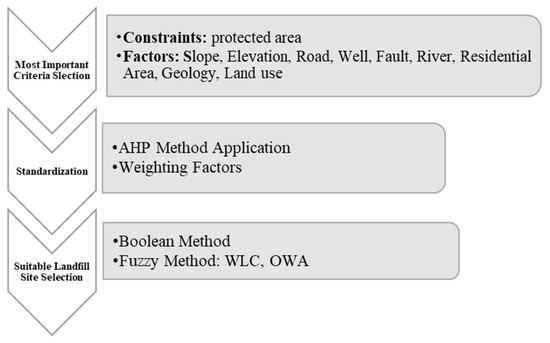
Figure 2.
Flowchart of the methodology adopted in the study.
S shape and linear membership function are the most prevalent indices that show the gradual changes to the complete membership. The linear membership function is calculated with Equation (1) [62]:
In Equation (1), is the first value (raw score) of the factor, is the minimum score, and is the maximum score.
The sigmoidal membership function is applied with the use of Equation (2) [63].
If the membership function is of the reduction type, will be calculated by Equation (3), and if it is of the increasing type, Equation (4) will be used to calculate [64].
In Equations (2)–(4), ,
, and are control points.
First, in the Boolean method, all criteria were converted to (0,1), and finally, they were combined with intersection (AND) and union (OR) operators. In this study, we used the “AND” operator because the Boolean is a method that cannot stand any risk. In this method, all criteria have maximum suitability [61]. Figure 3 shows the effective criteria used for site selection and the criteria used in the Boolean method.
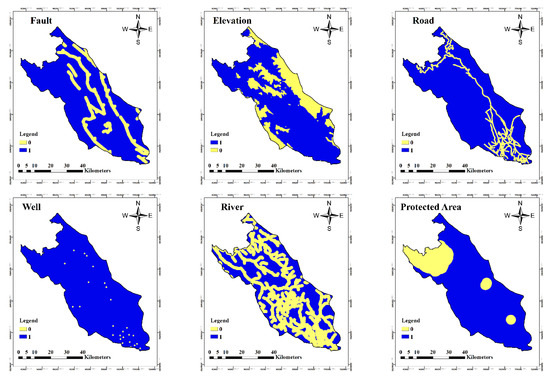
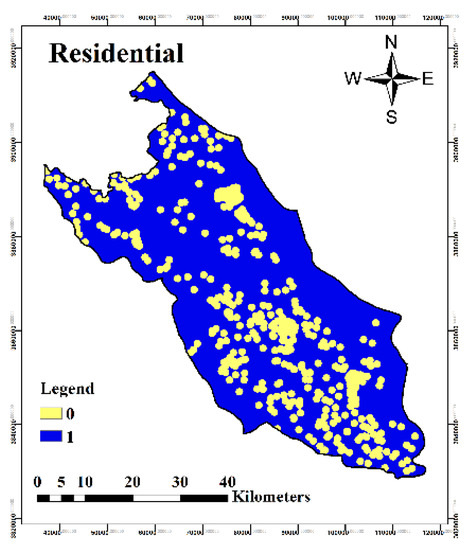
Figure 3.
The criteria used in the Boolean method.
3.1.1. Weighted Linear Combination
Weighted linear combination (WLC) or simple additive weighting (SAW) is the most common method in analyzing multi-criteria evaluation. Factors were combined by assigning a weight to each of them, followed by a summation of the results to yield a suitability map [62]. In the WLC method, the final suitability was obtained with the use of Equation (5).
where S is the final suitability, is the weight of factor i, and is the criterion score of factor i. Based on this equation, the alternative that has the maximum weight is more suitable for our goal. Equation (6) is used when constraints are applied as criteria [65].
where is the criterion score of constraint j, and is the product of the constraints.
The fundamental tools for evaluating such models are provided by all GIS software systems. In this study, the AHP method was utilized to weigh the criteria and compare effective factors by pairwise comparison (and the total amount of all weights of factors equal 1). For this method, the consistency ratio (CR) is a coefficient that shows the weight accuracy credit; this amount must be less than 0.1 [62]. Suitable site selection was performed based on two attributes: minimum area and maximum suitability. After selecting a suitable landfill site, the WLC method was used to prioritize the place by environmental criteria ([58]; Figure 4).
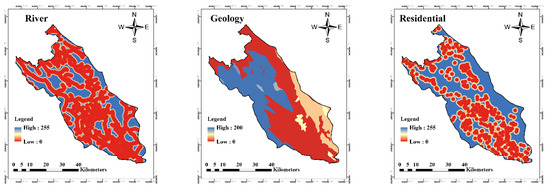
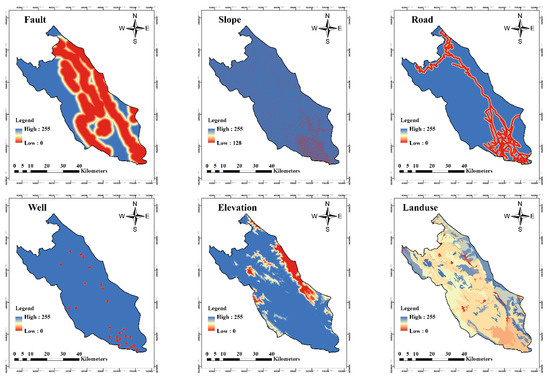
Figure 4.
The criteria of the fuzzy factor.
3.1.2. Ordered Weighted Averaging
The ordered weighted averaging (OWA) operator is a technique for ranking criteria and addressing the uncertainty from their interaction. This method employs a continuous scaling scenario with local and global weights between risk taking and risk averse. The OWA method was developed by [66] as a generalization of the Boolean coverage operations and WLC. The weighted averaging method is a complete spectrum of spatial strategic decisions that delivers the primary gradation dimensions in an extension between the involved criteria and risk measurement in the solution [62,67]. One of the abilities of the WLC method is that it has maximum compensation or trade-off. According to this feature, the criteria with more weight compensate for the criteria with less weight, and the WLC method facilitates the Boolean tough decision [62]. The OWA method calculates the amount of risk in the final site selection. This method is a combination of multi criteria evaluating (MCE) that includes two groups; the first one controls the role of the specific criteria, and the second one controls the total weight [68].
4. Results and Discussion
The results from the application of the presented methodology were zones of varying regional land suitability. To facilitate decision making, the zones were rated in decreasing order based on the value of their regional land suitability. In the case of fuzzy membership, after the determination of the effective criteria layers in the site selection, the criteria were standardized with the use of the fuzzy membership function (Table 3).

Table 3.
Control point and fuzzy membership function to standardize the used factors.
According to the AHP method weighting, the maximum weight was related to the slope (0.2936), distance from the fault, and elevation (0.1705), and the minimum weight was related to the geology (0.0312), which may be why geology overlaps with another Boolean factor (Table 4).

Table 4.
AHP pairwise comparison and their weights.
Due to the fact that land use and geology maps have no units, their classes were scored separately, which were quantified according to the amount of suitability and were standardized based on the increasing fuzzy function (Table 5 and Table 6).

Table 5.
Value of different land uses in fuzzy and Boolean methods.

Table 6.
Value of different geologies in fuzzy and Boolean methods.
The OWA method can rank the “AND” scenario and “OR” scenario, and here, this ranking was performed by global and local weighting. Global weighting was determined according to the decision-maker’s judgment, or by paired comparison to compensate control for another criterion, while the local weight was based on the pixel rank of a weighted factor and the AHP ranking [68,69]. One of the advantages of the OWA method is that researchers can produce a lot of maps and solve the problems related to them by reordering and changing criteria. This method shows a scenario between “AND” and “OR” against the Boolean method that only shows the “AND” scenario [70]. The level of the trade-off between criteria is directly controlled by the ordered weights [71]. The degree of dispersion of weight is controlled by the trade-off that shows the amount of compensation. Below, tables show the level of compensation and risk control (Figure 5).
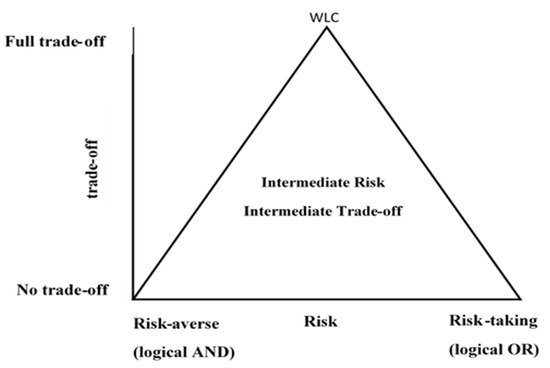
Figure 5.
Decision strategy space: the Boolean trend and WLC position.
The effective criteria in the Boolean method show that maximum constraints were related to distance from the residential area, distance from rivers, and distance from protected areas (Figure 3). The result of the criteria overlay using the Boolean method shows that 0.096 percent of the study area (26593 ha) has suitable landfill conditions (Figure 6, Table 7).
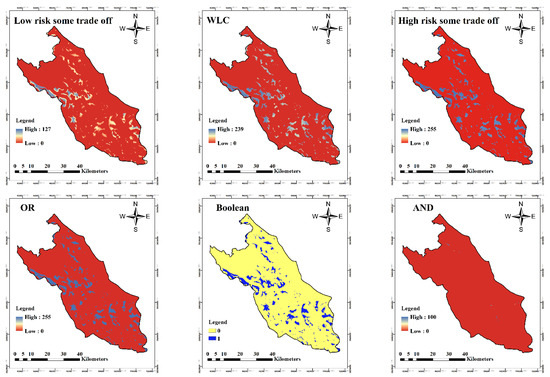
Figure 6.
Suitability maps derived by Boolean, OWA, and WLC methods.

Table 7.
Weight of OWA for compensation of risk.
The result from the WLC method illustrates that about 95.5 percent of the study area does not have any suitable site for landfill. The final output amount of suitability was 112,690 ha. Based on slope, geology, land use, elevation, and distance from the river, road, fault, protected areas, and residential areas, the OWA and WLC methodologies identified 15 sites for landfill, whose zonal land suitability ranged from 98 to 253 (Table 8, Table 9 and Table 10). This study attempted to evaluate the general suitability of all available regions for landfilling in order to assist in the selection of restricted sites in subsequent investigations. At this point, it is critical to note that the actual availability of landfill areas may be significantly lower than what is expressed in Table 8, Table 9 and Table 10. Other considerations of the land should be taken into account, such as more analysis of present and future land uses, the land’s economic benefits, and so on. In terms of proximity to the three cities, 2 of the 15 selected sites that met the environmental criteria (a, b) received the highest score (Figure 7 and Figure 8). Site (a) was acquired through the WLC, and site (b) was acquired using OWA-low risk trade-off (LRST) techniques.

Table 8.
Shows result from WLC site selection.

Table 9.
Shows the result of (LRST) site selection.

Table 10.
Shows the result of high risk some trade-off (HRST) site selection.
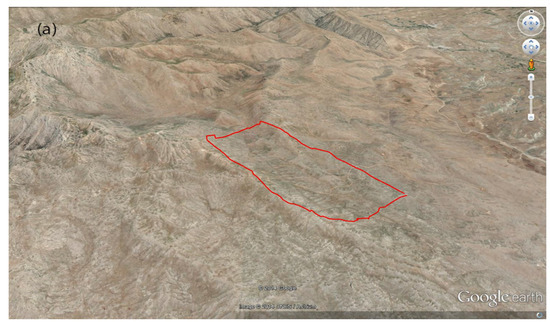
Figure 7.
Location of the site (a).
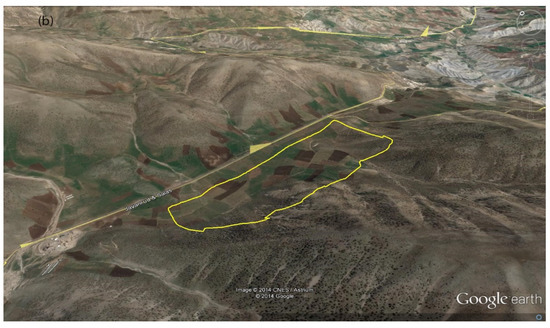
Figure 8.
Location of the site (b).
After small areas are selected by general criteria, the procedure is implemented because most of these criteria require extensive field surveys. The investigation of the suitability level at which the sites were selected during the allocation process revealed that there was little eligible land for landfilling. This has an impact on the waste treatment system’s costs as well as the health of the environment and the residents. In particular, using places with inadequate soil or those close to rivers will result in low suitability. On these occasions, it is supposed to apply more advanced techniques and tools to improve environmental protection, which raises expenses. In addition, using land in proximity to residential areas may result in low appropriateness, which might cause a lot of public contention. Based on fundamental problem solving, planning and management are founded. Beginning with the definition and description of the problem, they then move on to different types of analyses, such as simulation and modeling, and then progress to prediction, prescription, and eventually design, which frequently comprises assessing potential solutions to the problem [72]. The large number of methods provided to help decision makers with planning tasks, according to Khan et al. [73], contain modeling tools. The methodology described in this study exhibits the use of GIS as a decision support system and combines the assessment capabilities of the MCDM with the analytical tools of GIS. Combining all of the criteria (factors and constraints) for landfill along with the minimum area desired restriction (20 ha), the model’s initial phase evaluates if there is available land for landfills.
According to the land-use factors, site (a) is in a poor pasture, and site (b) is located in dryland farming; therefore, based on the economic factors, site (a) is a better choice than site (b). Another point that should be taken into consideration is the distance from the road; site (b) is near the road, but site (a) is far from the main road, which needs a new one to be constructed to reach the main road. The area of site (a) is 136 ha, and the area of site (b) is about 42 ha; consequently, site (a) is better than site (b). Site (a) is nearer to three cities, compared to site (b), so (a) is more suitable.
5. Conclusions
The ability of GIS and remote-sensing techniques to handle large volumes of data from various sources and their usage in an organized and systematic manner makes them very useful in the site-selection process, where multi-criteria evaluation can be effectively applied to address the issues related to municipal solid waste management due to its low cost and rapid implementation. This study sought to demonstrate how the combination application of AHP and the fuzzy logic-WLC and OWA methods based on MCDM succeeds in municipalities with the conditions of these three cities. The most important results of this research include the following:
- The location of the case study is in a mountainous area with steep slopes which decreases the final suitability. By surveying the current landfills in these three cities, it was concluded that some criteria are not regarded, such as site area for future, distance from the residential area, well, fault, river, and agriculture.
- Due to the different criteria units used in the site selection, the final data were standardized by weighting the criteria, and then the suitability map was produced. Therefore, in the Boolean method, there is a limit to the selection of places that have little area. Among these methods, OWA and WLC showed better efficiency, due to the constraint in the Boolean method.
- Out of 15 sites that were chosen based on the required criteria, two sites were considered the most suitable candidates since they matched all the requirements. Ultimately, only one site was introduced in this research based on land use, economics, social criteria, and other factors.
It is advised for future studies that the choice of parameters and even methods be based on climate, vegetation type, and other considerations affecting the type of landfill. In this research, 10 parameters were used, which could be expanded in the future to lead to more accurate results, such as groundwater depth and dominant wind direction of the study area.
Author Contributions
S.M.M.: Conceptualization, Methodology, Software, Writing—original draft. G.D.: Methodology, Software, Writing—original draft. N.M.D.: Conceptualization, Writing—original draft. S.A.N.: Conceptualization, Writing—original draft. All authors have read and agreed to the published version of the manuscript.
Funding
This research is supported by the MECW research program and the Centre for Advanced Middle Eastern Studies, Lund University. The authors gratefully acknowledge the National Geoscience Database of Iran, the Department of Environment, the Statistical Center of Iran, and the Natural Resources and Watershed Management Organization for providing data and making it accessible.
Data Availability Statement
The data presented in this study are available on request from the author.
Acknowledgments
The authors gratefully acknowledge the National Geoscience Database of Iran, the Department of Environment, the Statistical Center of Iran, and the Natural Resources and Watershed Management Organization for providing data and making it accessible.
Conflicts of Interest
The authors declare no conflict of interest. The funders had no role in the design of the study; in the collection, analyses, or interpretation of data; in the writing of the manuscript; or in the decision to publish the results.
References
- Rahimi, S.; Hafezalkotob, A.; Monavari, S.M.; Hafezalkotob, A.; Rahimi, R. Sustainable landfill site selection for municipal solid waste based on a hybrid decision-making approach: Fuzzy group BWM-MULTIMOORA-GIS. J. Clean. Prod. 2020, 248, 119186. [Google Scholar] [CrossRef]
- Sayadi, M.; Rezaei, M.; Rezaei, A. Fraction distribution and bioavailability of sediment heavy metals in the environment surrounding MSW landfill: A case study. Environ. Monit. Assess. 2015, 187, 4110. [Google Scholar] [CrossRef]
- Golkar, F.; Mousavi, S.M. Variation of XCO2 anomaly patterns in the Middle East from OCO-2 satellite data. Int. J. Digit. Earth 2022, 15, 1218–1234. [Google Scholar] [CrossRef]
- Mousavi, S.M.; Dinan, N.M.; Ansarifard, S.; Sonnentag, O. Analyzing spatio-temporal patterns in atmospheric carbon dioxide concentration across Iran from 2003 to 2020. Atmos. Environ. X 2022, 14, 100163. [Google Scholar] [CrossRef]
- Mallick, J. Municipal Solid Waste Landfill Site Selection Based on Fuzzy-AHP and Geoinformation Techniques in Asir Region Saudi Arabia. Sustainability 2021, 13, 1538. [Google Scholar] [CrossRef]
- Şener, E.; Şener, Ş. Landfill site selection using integrated fuzzy logic and analytic hierarchy process (AHP) in lake basins. Arab. J. Geosci. 2020, 13, 1130. [Google Scholar] [CrossRef]
- Javaheri, H.; Nasrabadi, T.; Jafarian, M.; Rowshan, G.; Khoshnam, H. Site selection of municipal solid waste landfills using analytical hierarchy process method in a geographical information technology environment in Giroft. J. Environ. Health Sci. Eng. 2006, 3, 177–184. [Google Scholar]
- Joshi, R.; Ahmed, S. Status and challenges of municipal solid waste management in India: A review. Cogent Environ. Sci. 2016, 2, 1139434. [Google Scholar] [CrossRef]
- Mandal, K. Review on evolution of municipal solid waste management in India: Practices, challenges and policy implications. J. Mater. Cycles Waste Manag. 2019, 21, 1263–1279. [Google Scholar]
- Besharati Fard, M.; Hamidi, D.; Ebadi, M.; Alavi, J.; McKay, G. Optimum landfill site selection by a hybrid multi-criteria and multi-Agent decision-making method in a temperate and humid climate: BWM-GIS-FAHP-GT. Sustain. Cities Soc. 2022, 79, 103641. [Google Scholar] [CrossRef]
- David, V.E.; John, Y.; Hussain, S. Rethinking sustainability: A review of Liberia’s municipal solid waste management systems, status, and challenges. J. Mater. Cycles Waste Manag. 2020, 22, 1299–1317. [Google Scholar] [CrossRef]
- Nabavi-Pelesaraei, A.; Mohammadkashi, N.; Naderloo, L.; Abbasi, M.; Chau, K.-W. Principal of environmental life cycle assessment for medical waste during COVID-19 outbreak to support sustainable development goals. Sci. Total Environ. 2022, 827, 154416. [Google Scholar] [CrossRef] [PubMed]
- Nanda, S.; Berruti, F. Municipal solid waste management and landfilling technologies: A review. Environ. Chem. Lett. 2021, 19, 1433–1456. [Google Scholar] [CrossRef]
- Pujara, Y.; Pathak, P.; Sharma, A.; Govani, J. Review on Indian Municipal Solid Waste Management practices for reduction of environmental impacts to achieve sustainable development goals. J. Environ. Manag. 2019, 248, 109238. [Google Scholar] [CrossRef]
- Babalola, A.; Busu, I. Selection of Landfill Sites for Solid Waste Treatment in Damaturu Town-Using GIS Techniques. J. Environ. Prot. 2011, 2, 1–10. [Google Scholar] [CrossRef]
- Rezaeisabzevar, Y.; Bazargan, A.; Zohourian, B. Landfill site selection using multi criteria decision making: Influential factors for comparing locations. J. Environ. Sci. 2020, 93, 170–184. [Google Scholar] [CrossRef]
- Bottero, M.; Comino, E.; Riggio, V. Application of the analytic hierarchy process and the analytic network process for the assessment of different wastewater treatment systems. Environ. Model. Softw. 2011, 26, 1211–1224. [Google Scholar] [CrossRef]
- Fernando, R.L.S. Solid waste management of local governments in the Western Province of Sri Lanka: An implementation analysis. Waste Manag. 2019, 84, 194–203. [Google Scholar] [CrossRef]
- Rahmasary, A.N.; Robert, S.; Chang, I.; Jing, W.; Park, J.; Bluemling, B.; Koop, S.; van Leeuwen, K. Overcoming the challenges of water, waste and climate change in Asian cities. Environ. Manag. 2019, 63, 520–535. [Google Scholar] [CrossRef]
- Abdel-Shafy, H.I.; Mansour, M.S. Solid waste issue: Sources, composition, disposal, recycling, and valorization. Egypt. J. Pet. 2018, 27, 1275–1290. [Google Scholar] [CrossRef]
- Isalou, A.; Zamani, V.; Shahmoradi, B.; Alizadeh, H. Landfill site selection using integrated fuzzy logic and analytic network process (F-ANP). Environ. Earth Sci. 2013, 68, 1745–1755. [Google Scholar] [CrossRef]
- Rouhani, A. Municipal Solid Waste Disposal Site Selection Using Remote Sensing Technology and AHP Process (Case Study: Khesht city, Fars Province, Iran). Brill. Eng. 2021, 3, 4535. [Google Scholar] [CrossRef]
- Akbari, V.; Rajabi, M.; Chavoshi, S.; Shams, R. Landfill site selection by combining GIS and fuzzy multi criteria decision analysis, case study: Bandar Abbas, Iran. World Appl. Sci. J. 2008, 3, 39–47. [Google Scholar]
- Curcic, S.; Tadic, D.; Pavlovic, M.; Arsovski, S.; Milunovic, S. Fuzzy multi-criteria model for selecting the best location for a regional landfill. Rev. Chim. 2011, 62, 825–831. [Google Scholar]
- Rezazadeh, M.; Seyedmahalleh, E.S.; Seyedmahalleh, E.S.; Mehrdadi, N.; Kootenaei, F.G. Landfill Site Selection for Babol Using Fuzzy logic Method. J. Civ. Eng. Urban. 2014, 4, 261–265. [Google Scholar]
- Danesh, G.; Monavari, M.; Omrani, G.A.; Karbasi, A.; Farsad, F. Application of Multi-Criteria Decision-Making Models Based on Geographic Information Systems in Locating Hazardous Waste Disposal Sites (Case Study: Bushehr Province). Environ. Sci. Technol. 2019, 23, 87–101. [Google Scholar]
- Sisay, G.; Gebre, S.L.; Getahun, K. GIS-based potential landfill site selection using MCDM-AHP modeling of Gondar Town, Ethiopia. Afr. Geogr. Rev. 2020, 40, 105–124. [Google Scholar] [CrossRef]
- Dashtian, A.; Rouhani, A.; Dashtian, A. Municipal Solid Waste Disposal Site Selection Using Remote Sensing Technology and AHP Process (Case Study: Khesht city, Fars Province, Iran). J. Brill. Eng. 2022, 2, 4535. [Google Scholar]
- Kaghazchi, M.E.; Pourmanafi, S.; Peykanpour Fard, R. Urban landfill site selection with combined environmental and socio-economic criteria in Naein County and estimation of its possible emitted biogas. Environ. Sci. 2021, 19, 53–70. [Google Scholar] [CrossRef]
- Mortazavi Chamchali, M.; Mohebbi Tafreshi, A.; Mohebbi Tafreshi, G. Utilizing GIS linked to AHP for landfill site selection in Rudbar County of Iran. Geo. J. 2021, 86, 163–183. [Google Scholar] [CrossRef]
- Chabok, M.; Asakereh, A.; Bahrami, H.; Jaafarzadeh, N.O. Selection of MSW landfill site by fuzzy-AHP approach combined with GIS: Case study in Ahvaz, Iran. Environ. Monit. Assess. 2020, 192, 433. [Google Scholar] [CrossRef]
- Khorsandi, H.; Faramarzi, A.; Aghapour, A.A.; Jafari, S.J. Landfill site selection via integrating multi-criteria decision techniques with geographic information systems: A case study in Naqadeh, Iran. Environ. Monit. Assess. 2019, 191, 730. [Google Scholar] [CrossRef]
- Omidikhah Deylami, M.; Monavari, M.; Omrani, G.A. Landfill Site Selection with Regional and Local Screening Method in East of Guilan Province. Town Ctry. Plan. 2013, 5, 101–132. [Google Scholar] [CrossRef]
- Manguri, S.B.H.; Hamza, A.A. Sanitary Landfill Site Selection Using Spatial-AHP for Pshdar Area, Sulaymaniyah, Kurdistan Region/Iraq. Iran. J. Sci. Technol. Trans. Civ. Eng. 2022, 46, 1345–1358. [Google Scholar] [CrossRef]
- Benezzine, G.; Zouhri, A.; Koulali, Y. AHP and GIS-Based Site Selection for a Sanitary Landfill: Case of Settat Province, Morocco. J. Ecol. Eng. 2022, 23, 1–13. [Google Scholar] [CrossRef]
- Carević, I.; Sibinović, M.; Manojlović, S.; Batoćanin, N.; Petrović, A.S.; Srejić, T. Geological Approach for landfill site selection: A case study of Vršac Municipality, Serbia. Sustainability 2021, 13, 7810. [Google Scholar] [CrossRef]
- Kilicoglu, C.; Cetin, M.; Aricak, B.; Sevik, H. Site selection by using the multi-criteria technique—a case study of Bafra, Turkey. Environ. Monit. Assess. 2020, 192, 608. [Google Scholar] [CrossRef]
- Asif, K.; Chaudhry, M.N.; Ashraf, U.; Ali, I.; Ali, M. A GIS-based multi-criteria evaluation of landfill site selection in Lahore, Pakistan. Pol. J. Environ. Stud. 2020, 29, 1511–1521. [Google Scholar] [CrossRef]
- Barzehkar, M.; Dinan, N.M.; Mazaheri, S.; Tayebi, R.M.; Brodie, G.I. Landfill site selection using GIS-based multi-criteria evaluation (case study: SaharKhiz Region located in Gilan Province in Iran). SN Appl. Sci. 2019, 1, 1082. [Google Scholar] [CrossRef]
- Chamchali, M.M.; Ghazifard, A. A comparison of fuzzy logic and TOPSIS methods for landfill site selection according to field visits, engineering geology approach and geotechnical experiments (case study: Rudbar County, Iran). Waste Manag. Res. 2021, 39, 325–350. [Google Scholar] [CrossRef]
- Pasalari, H.; Nodehi, R.N.; Mahvi, A.H.; Yaghmaeian, K.; Charrahi, Z. Landfill site selection using a hybrid system of AHP-Fuzzy in GIS environment: A case study in Shiraz city, Iran. Methods X 2019, 6, 1454–1466. [Google Scholar] [CrossRef] [PubMed]
- Zarin, R.; Azmat, M.; Naqvi, S.R.; Saddique, Q.; Ullah, S. Landfill site selection by integrating fuzzy logic, AHP, and WLC method based on multi-criteria decision analysis. Environ. Sci. Pollut. Res. Int. 2021, 28, 19726–19741. [Google Scholar] [CrossRef]
- Ghosh, S.; Das Chatterjee, N.; Dinda, S. Urban ecological security assessment and forecasting using integrated DEMATEL-ANP and CA-Markov models: A case study on Kolkata Metropolitan Area, India. Sustain. Cities Soc. 2021, 68, 102773. [Google Scholar] [CrossRef]
- Mohsin, M.; Ali, S.A.; Shamim, S.K.; Ahmad, A. A GIS-based novel approach for suitable sanitary landfill site selection using integrated fuzzy analytic hierarchy process and machine learning algorithms. Environ. Sci. Pollut. Res. Int. 2022, 29, 31511–31540. [Google Scholar] [CrossRef] [PubMed]
- Ali, S.A.; Parvin, F.; Al-Ansari, N.; Pham, Q.B.; Ahmad, A.; Raj, M.S.; Anh, D.T.; Ba, L.H.; Thai, V.N. Sanitary landfill site selection by integrating AHP and FTOPSIS with GIS: A case study of Memari Municipality, India. Environ. Sci. Pollut. Res. Int. 2021, 28, 7528–7550. [Google Scholar] [CrossRef] [PubMed]
- Majid, M.; Mir, B.A. Landfill site selection using GIS based multi criteria evaluation technique. A case study of Srinagar city, India. Environ. Chall. 2021, 3, 100031. [Google Scholar] [CrossRef]
- Ali, S.A.; Ahmad, A. Suitability analysis for municipal landfill site selection using fuzzy analytic hierarchy process and geospatial technique. Environ. Earth Sci. 2020, 79, 227. [Google Scholar] [CrossRef]
- Karimi, H.; Amiri, S.; Huang, J.; Karimi, A. Integrating GIS and multi-criteria decision analysis for landfill site selection, case study: Javanrood County in Iran. Int. J. Environ. Sci. Technol. 2019, 16, 7305–7318. [Google Scholar] [CrossRef]
- Al-Ruzouq, R.; Abdallah, M.; Shanableh, A.; Alani, S.; Obaid, L.; Gibril, M.B.A. Waste to energy spatial suitability analysis using hybrid multi-criteria machine learning approach. Environ. Sci. Pollut. Res. 2022, 29, 2613–2628. [Google Scholar] [CrossRef]
- Bilgilioglu, S.S.; Gezgin, C.; Orhan, O.; Karakus, P. A GIS-based multi-criteria decision-making method for the selection of potential municipal solid waste disposal sites in Mersin, Turkey. Environ. Sci. Pollut. Res. 2022, 29, 5313–5329. [Google Scholar] [CrossRef]
- Cobos-Mora, S.L.; Guamán-Aucapiña, J.; Zúñiga-Ruiz, J. Suitable site selection for transfer stations in a solid waste management system using analytical hierarchy process as a multi-criteria decision analysis: A case study in Azuay-Ecuador. Environ. Dev. Sustain. 2022, 1–34. [Google Scholar] [CrossRef]
- Gorsevski, P.V.; Donevska, K.R.; Mitrovski, C.D.; Frizado, J.P. Integrating multi-criteria evaluation techniques with geographic information systems for landfill site selection: A case study using ordered weighted average. Waste Manag. 2012, 32, 287–296. [Google Scholar] [CrossRef] [PubMed]
- Sharifi, M.; Hadidi, M.; Vessali, E.; Mosstafakhani, P.; Taheri, K.; Shahoie, S.; Khodamoradpour, M. Integrating multi-criteria decision analysis for a GIS-based hazardous waste landfill sitting in Kurdistan Province, western Iran. Waste Manag. 2009, 29, 2740–2758. [Google Scholar] [CrossRef]
- Soleymani, M.; Asakereh, A.; Safieddin Ardebili, S.M. A GIS-based multi-criteria fuzzy approach to select a suitable location for a MSW-based power plant and landfill: A case study, Khuzestan province, Iran. Environ. Monit. Assess. 2022, 194, 1–20. [Google Scholar] [CrossRef]
- Eghtesadifard, M.; Afkhami, P.; Bazyar, A. An integrated approach to the selection of municipal solid waste landfills through GIS, K-Means and multi-criteria decision analysis. Environ. Res. 2020, 185, 109348. [Google Scholar] [CrossRef] [PubMed]
- Özkan, B.; Özceylan, E.; Sarıçiçek, İ. GIS-based MCDM modeling for landfill site suitability analysis: A comprehensive review of the literature. Environ. Sci. Pollut. Res. 2019, 26, 30711–30730. [Google Scholar] [CrossRef] [PubMed]
- Bahrani, S.; Ebadi, T.; Ehsani, H.; Yousefi, H.; Maknoon, R. Modeling landfill site selection by multi-criteria decision making and fuzzy functions in GIS, case study: Shabestar, Iran. Environ. Earth Sci. 2016, 75, 337. [Google Scholar] [CrossRef]
- Rahmat, Z.G.; Niri, M.V.; Alavi, N.; Goudarzi, G.; Babaei, A.A.; Baboli, Z.; Hosseinzadeh, M. Landfill site selection using GIS and AHP: A case study: Behbahan, Iran. KSCE J. Civ. Eng. 2017, 21, 111–118. [Google Scholar] [CrossRef]
- Soroudi, M.; Omrani, G.; Moataar, F.; Jozi, S.A. Modelling an Integrated Fuzzy Logic and Multi-Criteria Approach for Land Capability Assessment for Optimized Municipal Solid Waste Landfill Siting Yeast. Pol. J. Environ. Stud. 2018, 27, 313–323. [Google Scholar] [CrossRef]
- Mahini, A.S.; Gholamalifard, M. Siting MSW landfills with a weighted linear combination methodology in a GIS environment. Int. J. Environ. Sci. Technol. 2006, 3, 435–445. [Google Scholar] [CrossRef]
- Drobne, S.; Lisec, A. Multi-attribute decision analysis in GIS: Weighted linear combination and ordered weighted averaging. Informatica 2009, 33, 459–474. [Google Scholar]
- Eastman, J. IDRISI Selva: Guide to GIS and Image Processing; Clark University: Worcester, MA, USA, 2012. [Google Scholar]
- VK, E.A.D. A GIS Multicriteria Model for Landfill Sitting. Glob. NEST J. 2007, 9, 29–34. [Google Scholar]
- Schernthanner, H. Fuzzy Logic Approach for Landslide Susceptibility Mapping, “Rio Blanco”, Nicaragua; na: 2005. Available online: https://www.researchgate.net/publication/285386772_Fuzzy_logic_approach_for_landslide_susceptibility_mapping_Rio_Blanco_Nicaragua_Schernthanner_Harald (accessed on 11 September 2022).
- Mahiny, A.S.; Gholamalifard, M. Linking SLEUTH urban growth modeling to multi criteria evaluation for a dynamic allocation of sites to landfill. Proceedings of International Conference on Computational Science and Its Applications, Santander, Spain, 20–23 June 2011; pp. 32–43. [Google Scholar]
- Yager, R.R. On ordered weighted averaging aggregation operators in multicriteria decisionmaking. IEEE Trans. Syst. Man Cybern. 1988, 18, 183–190. [Google Scholar] [CrossRef]
- Ferretti, V.; Pomarico, S. Ecological land suitability analysis through spatial indicators: An application of the Analytic Network Process technique and Ordered Weighted Average approach. Ecol. Indic. 2013, 34, 507–519. [Google Scholar] [CrossRef]
- Jiang, H.; Eastman, J.R. Application of fuzzy measures in multi-criteria evaluation in GIS. Int. J. Geogr. Inf. Sci. 2000, 14, 173–184. [Google Scholar] [CrossRef]
- Yager, R.R. Including importances in OWA aggregations using fuzzy systems modeling. IEEE Trans. Fuzzy Syst. 1998, 6, 286–294. [Google Scholar] [CrossRef]
- Malczewski, J. Fuzzy screening for land suitability analysis. Geogr. Environ. Model. 2002, 6, 27–39. [Google Scholar] [CrossRef]
- Malczewski, J. GIS and Multicriteria Decision Analysis; John Wiley & Sons: Hoboken, NJ, USA, 1999. [Google Scholar]
- Ayeni, B. The design of spatial decision support systems in urban and regional planning. In Decision Support Systems in Urban Planning; Routledge: London, UK, 2003; pp. 20–33. [Google Scholar]
- Khan, D.; Samadder, S.R. A simplified multi-criteria evaluation model for landfill site ranking and selection based on AHP and GIS. J. Environ. Eng. Landsc. Manag. 2015, 23, 267–278. [Google Scholar] [CrossRef]
Publisher’s Note: MDPI stays neutral with regard to jurisdictional claims in published maps and institutional affiliations. |
© 2022 by the authors. Licensee MDPI, Basel, Switzerland. This article is an open access article distributed under the terms and conditions of the Creative Commons Attribution (CC BY) license (https://creativecommons.org/licenses/by/4.0/).